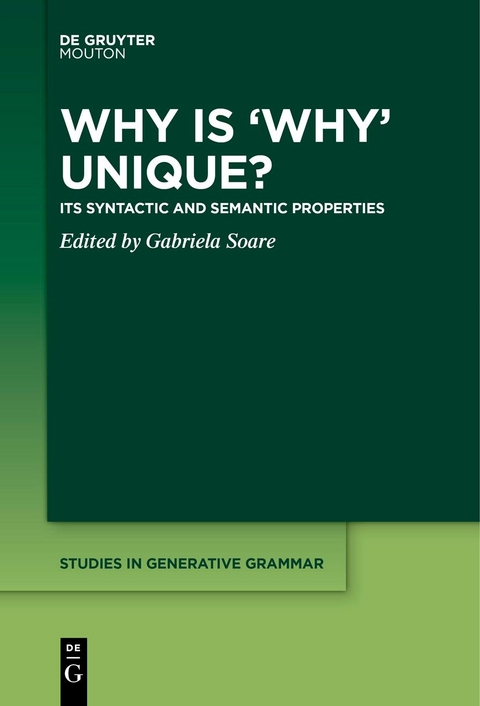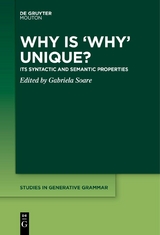Why is ‘Why’ Unique?
Its Syntactic and Semantic Properties
Seiten
2021
de Gruyter Mouton (Verlag)
978-3-11-067511-5 (ISBN)
de Gruyter Mouton (Verlag)
978-3-11-067511-5 (ISBN)
The architecture of the human language faculty has been one of the main foci of the linguistic research of the last half century. This branch of linguistics, broadly known as Generative Grammar, is concerned with the formulation of explanatory formal accounts of linguistic phenomena with the ulterior goal of gaining insight into the properties of the 'language organ'. The series comprises high quality monographs and collected volumes that address such issues. The topics in this series range from phonology to semantics, from syntax to information structure, from mathematical linguistics to studies of the lexicon.
Why is ‘Why’ Unique? Its Syntactic and Semantic Properties considers the behaviour of this peculiar wh-element across many different languages, including Ewe, Trevisan, Italian, Basque, German, Dutch, Cantonese, Mandarin, English and Hebrew. In ten original chapters, the authors explore various aspects of why-questions, such as the way why interacts with V2 constructions in Basque, with a subject clitic in Trevisan or how its morpho-syntactic make-up determines its merge position in Ewe, to mention but a few. Furthermore, a clear-cut distinction is established between high and low reason adverbials which are subsequently examined in why-stripping environments in Dutch. Beyond why proper, the book explores a special class of wh-expressions in some in-situ languages which give rise to unexpected why-construals with a touch of whining force. The objective is to explain the unusual syntactic position of these wh-expressions as well as their association with peculiar pragmatics. The questions are addressed for Cantonese: are what-initial sentences genuine questions? To what extent are Cantonese what-initial sentences similar to how-initial sentences in Mandarin? Beside these what-as-why questions, a special class of rhetorical questions, the doubly-marked interrogatives in Hebrew, come under scrutiny. Why is ‘why’ unique also concerns the interface with prosody and several experimental studies investigate precisely this aspect.
Why is ‘Why’ Unique? Its Syntactic and Semantic Properties considers the behaviour of this peculiar wh-element across many different languages, including Ewe, Trevisan, Italian, Basque, German, Dutch, Cantonese, Mandarin, English and Hebrew. In ten original chapters, the authors explore various aspects of why-questions, such as the way why interacts with V2 constructions in Basque, with a subject clitic in Trevisan or how its morpho-syntactic make-up determines its merge position in Ewe, to mention but a few. Furthermore, a clear-cut distinction is established between high and low reason adverbials which are subsequently examined in why-stripping environments in Dutch. Beyond why proper, the book explores a special class of wh-expressions in some in-situ languages which give rise to unexpected why-construals with a touch of whining force. The objective is to explain the unusual syntactic position of these wh-expressions as well as their association with peculiar pragmatics. The questions are addressed for Cantonese: are what-initial sentences genuine questions? To what extent are Cantonese what-initial sentences similar to how-initial sentences in Mandarin? Beside these what-as-why questions, a special class of rhetorical questions, the doubly-marked interrogatives in Hebrew, come under scrutiny. Why is ‘why’ unique also concerns the interface with prosody and several experimental studies investigate precisely this aspect.
Gabriela Soare, Université de Genève, Switzerland.
| Erscheinungsdatum | 26.08.2021 |
|---|---|
| Reihe/Serie | Studies in Generative Grammar [SGG] ; 142 |
| Zusatzinfo | 40 b/w ill., 1 b/w tbl. |
| Verlagsort | Basel/Berlin/Boston |
| Sprache | englisch |
| Maße | 155 x 230 mm |
| Gewicht | 595 g |
| Themenwelt | Geisteswissenschaften ► Sprach- / Literaturwissenschaft ► Anglistik / Amerikanistik |
| Geisteswissenschaften ► Sprach- / Literaturwissenschaft ► Sprachwissenschaft | |
| Sozialwissenschaften | |
| Schlagworte | Adjunkt • High and Low Reasons Adjuncts • Merge Position • Satzglied • 'What' as Why-questions • ‘What’ as Why-questions • Why-questions |
| ISBN-10 | 3-11-067511-0 / 3110675110 |
| ISBN-13 | 978-3-11-067511-5 / 9783110675115 |
| Zustand | Neuware |
| Haben Sie eine Frage zum Produkt? |
Mehr entdecken
aus dem Bereich
aus dem Bereich
Poetik eines sozialen Urteils
Buch | Hardcover (2023)
De Gruyter (Verlag)
CHF 83,90
Buch | Softcover (2024)
belleville (Verlag)
CHF 27,95




